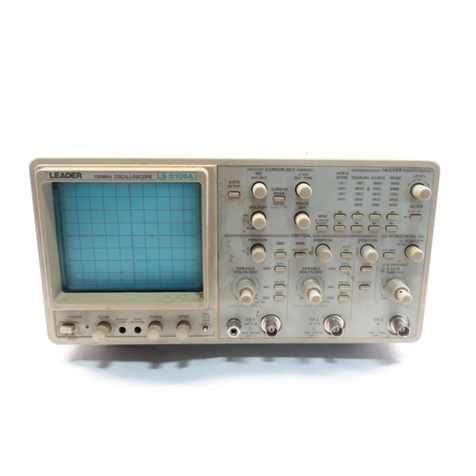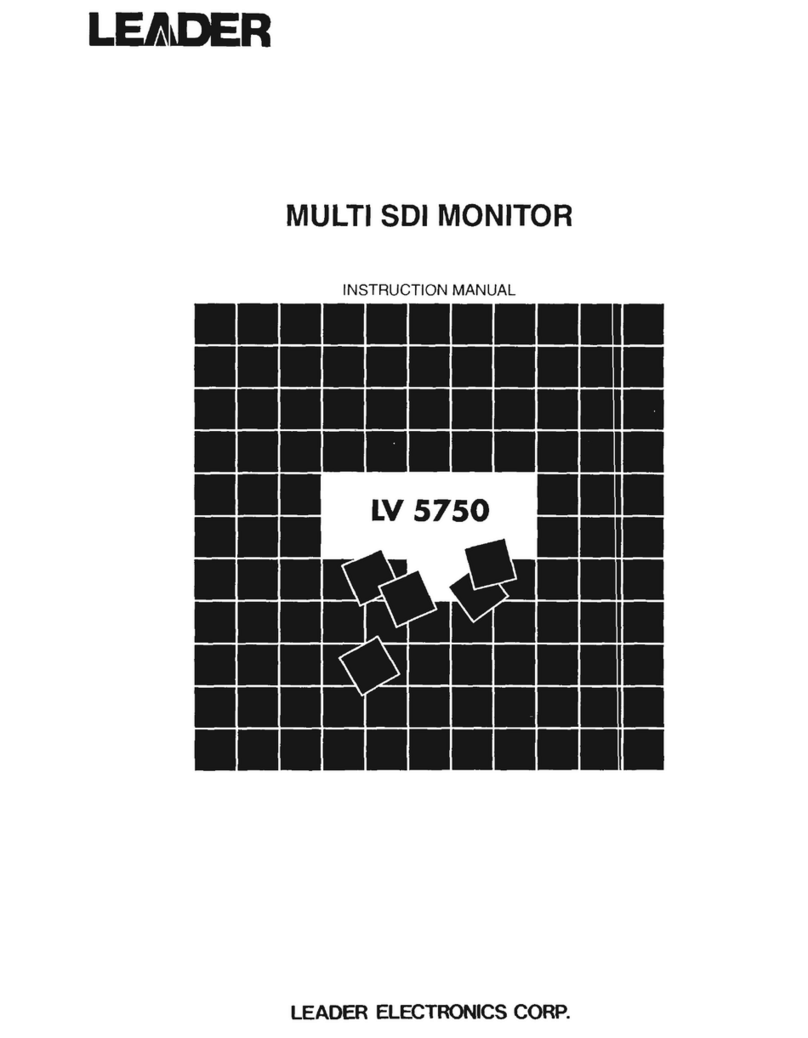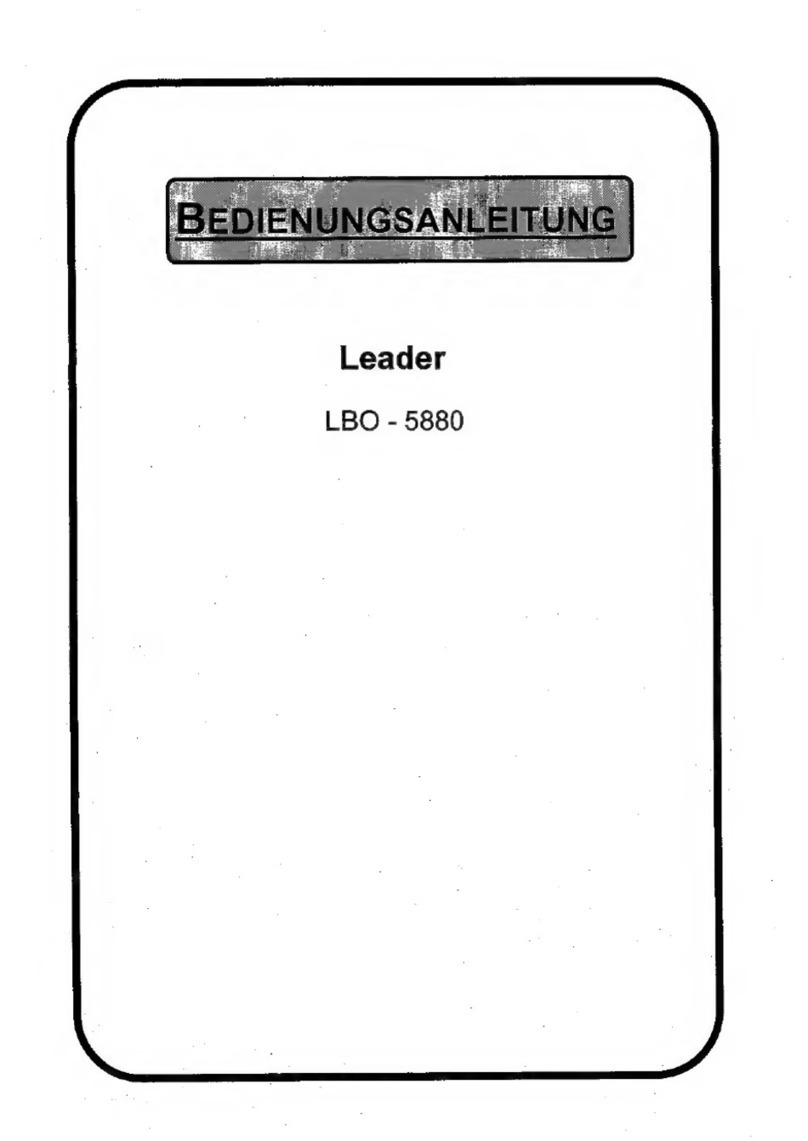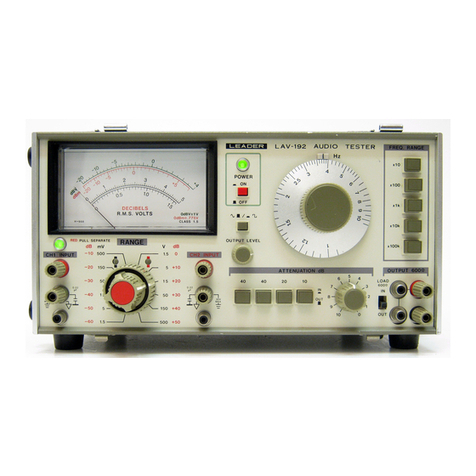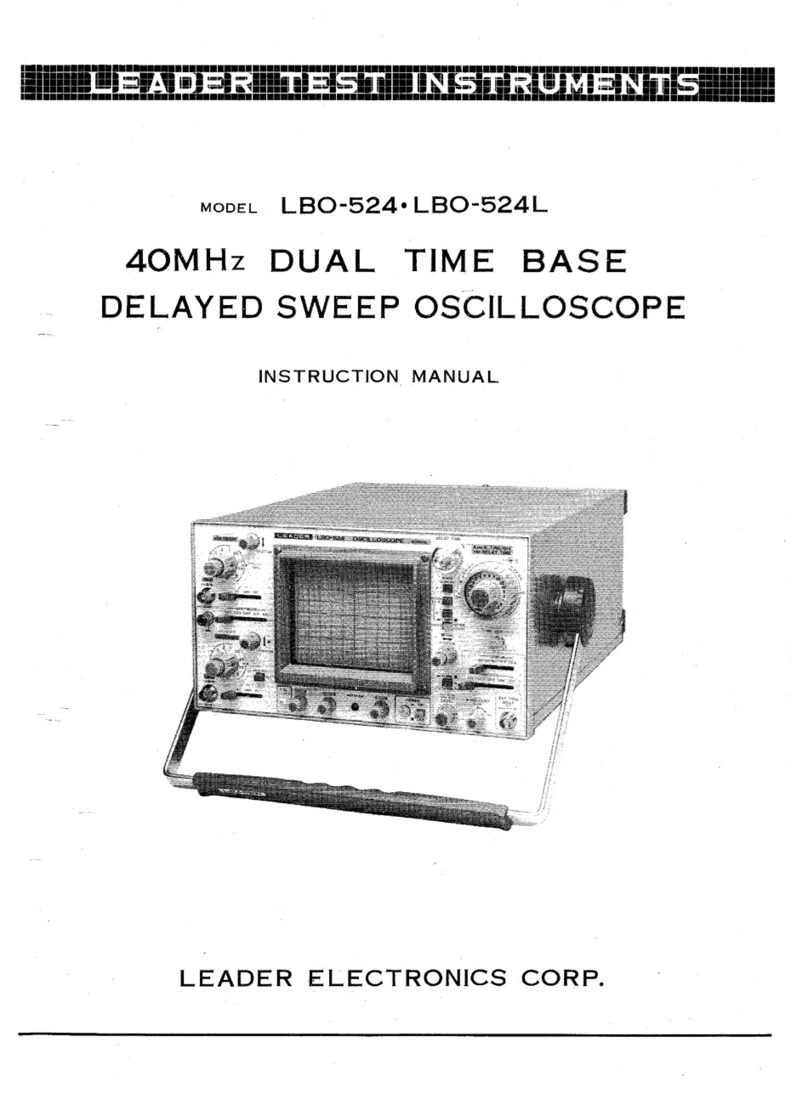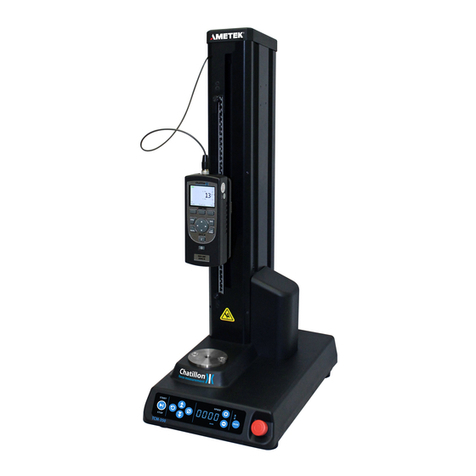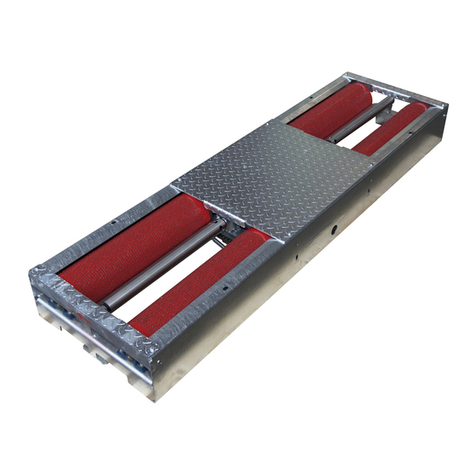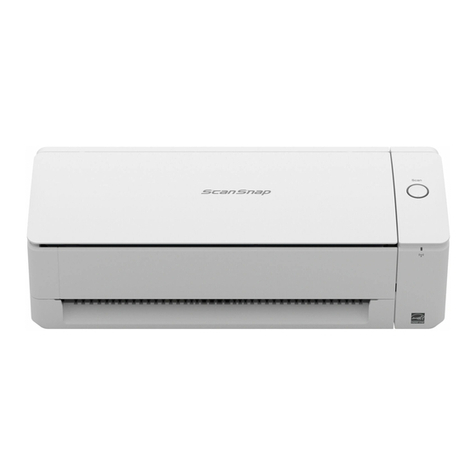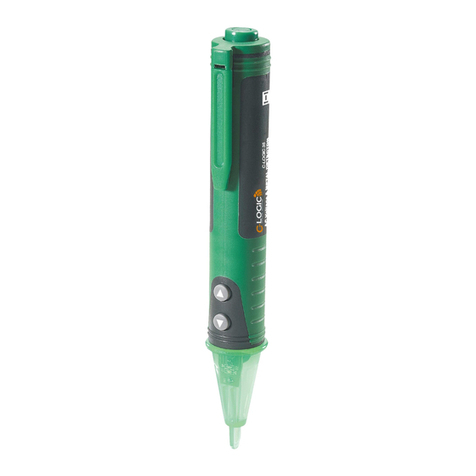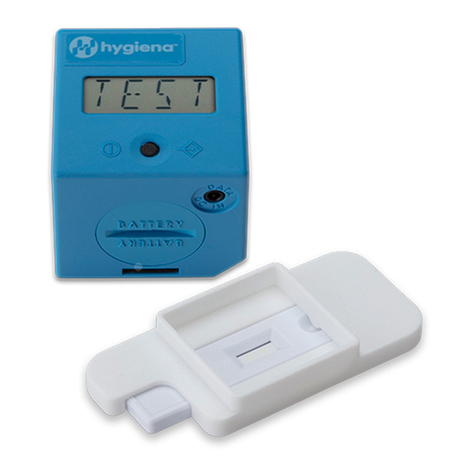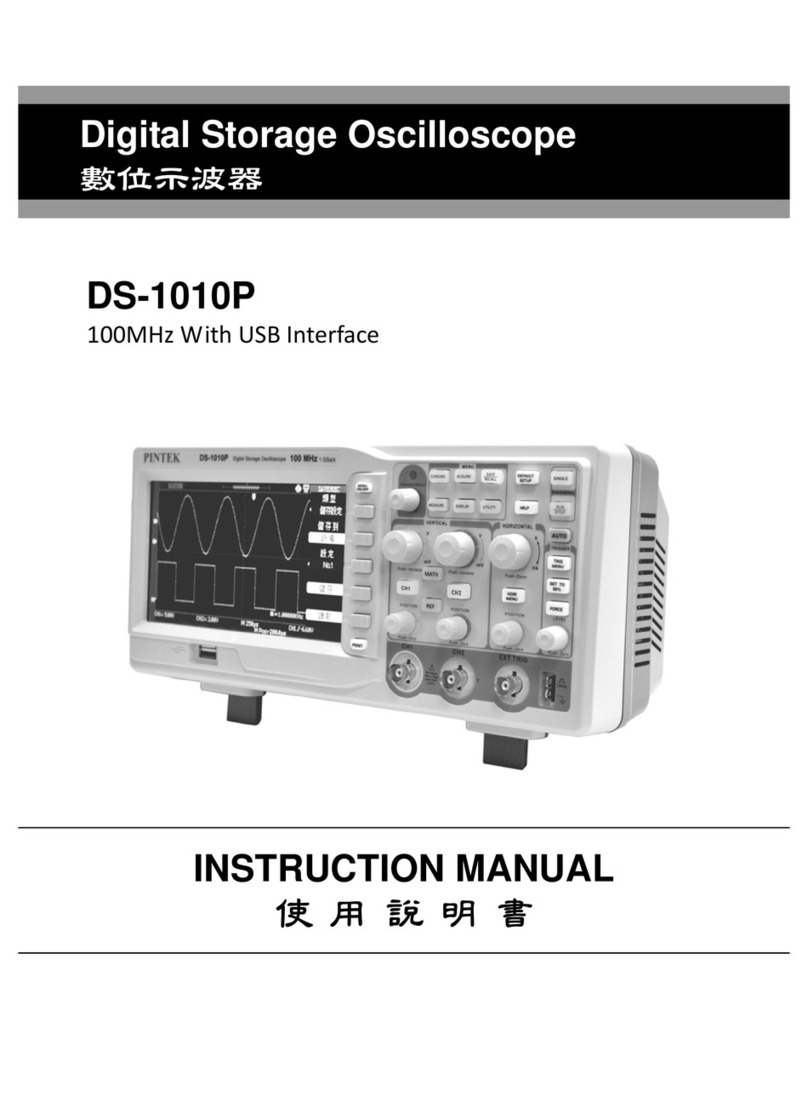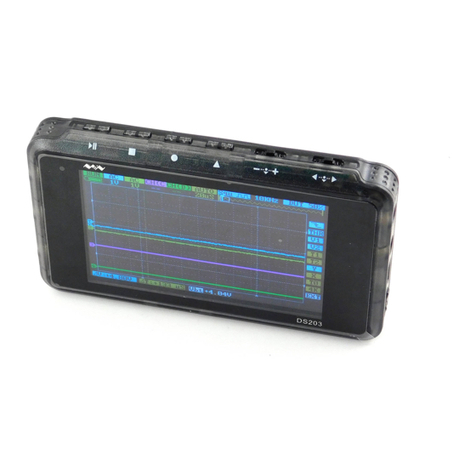Leader LBO-516 User manual


WARNING!
THE SERVICING INSTRUCTIONS CONTAINED IN THIS MANUAL ARE FOR
USE BY QUALIFIED PERSONNEL ONLY. TO AVOID ELECTRIC SHOCK, DO
NOT PERFORM ANY SERVICING OTHER THAN THAT CONTAINED IN THE
OPERATING INSTRUCTIONS UNLESS YOU ARE QUALIFIED TO DO SO.

LBO-516 100 MHz
DELAYED TIME BASE OSCIILOSCOPE
TABLE OF CONTENTS
1. GENERALINFORMATION........................................................................................................................................1
1-1 INTRODUCTION ................................................................................................................................1
1-2 SPECIFICATIONS ..........…..................................................................................................................................1
2. OPERATING INSTRUCTIONS..................................................................................................................................3
2-1 FUNCTION OF CONTROLS, CONNECTORS, AND INDICATORS .......................................................... 3
2-1-1 Display Block ........................................................................................................................................... 3
2-1-2 Vertical Amplifier Block ........................................................................................................................... 4
2-1-3 Sweep and Trigger Blocks ......................................................................................................................... 5
2-1-4 Miscellaneous ........................................................................................................................................... 7
2-2 INITIAL OPERATION ................................................................................................................................ 7
2-2-1 Power Connections and Adjustments ......................................................................................................... 7
2-2-2 Installation ................................................................................................................................................ 8
2-2-3 Preliminary Control Settings and Adjustments ........................................................................................... 8
2-3 BASIC OPERATING PROCEDURES ......................................................................................................... 9
2-3-1 Signal Connections ................................................................................................................................... 9
2-3-2 Single-trace Operation ..............................................................................................................................11
2-3-3 Triggering Alternatives ............................................................................................................................11
2-3-4 Probe Compensation ................................................................................................................................14
2-3-5 Dual-trace Operation ................................................................................................................................15
2-3-6 Additive and Differential Operation ..........................................................................................................16
2-3-7 Triple-trace Operation ..............................................................................................................................17
2-3-8 Four-trace Operation ................................................................................................................................17
2-3-9 Delayed Timebase Operation ....................................................................................................................18
2-3-10 Single-shot Operation .............................................................................................................................20
2-3-11 X-Y Operation .......................................................................................................................................20
2-3-12 Intensity Modulation ..............................................................................................................................20
2-4 MEASUREMENT APPLICATIONS ...........................................................................................................21
2-4-1 Amplitude Measurements .........................................................................................................................21
2-4-2 Differential Measurement Techniques .......................................................................................................22
2-4-3 Time Interval Measurements ....................................................................................................................23
2-4-4 Phase Difference Measurements ...............................................................................................................24
2-4-5 Distortion Comparison .............................................................................................................................26
2-4-6 Frequency Measurements .........................................................................................................................27
2-4-7 Risetime Measurements ............................................................................................................................27
2-4-8 -3dB Bandwidth Measurement ..................................................................................................................28

1. GENERAL INFORMATION
1-1. INTRODUCTION
The LBO-516, shown in Figure 1-1, is a 100 MHz oscilloscope
with all of the features normally found on a lab-grade scope: high-
fidelity pulse response, stable operation, dual timebase with
calibrated sweep delay, flexible triggering facilities, and a bright
CRT display with illuminated internal graticule. Moreover, it also has
a very unusual feature found on few scopes in any price class: it can
simultaneously display up to eight traces from three different input
signals! In addition to the two vertical-input channels and their differ-
ence signal, the signal used to externally trigger the main timebase
can also appear on the CRT display. The alternate sweep mode,
which allows the main and delayed timebases to simultaneously
sweep the CRT, effectively doubles this four-trace display to an
eight-trace display.
The comprehensive triggering facilities of the LBO-516 include
several features that ease the problem of triggering on complex
signals: a variety of frequency-selective coupling filters, a trigger
holdoff-control, and a trigger pickoff that alternates between the two
vertical channels.
1-2. SPECIFICATIONS
Specifications for the model LBO-516 oscilloscope are given in
Table 1-1.
Table 1-1
SPECIFICATIONS
Vertical Amplifiers (Ch. 1 & 2)
Bandwidth (-3 dB)
DC coupled DC - 100 MHz
AC coupled 10 Hz - 100 MHz
Rise Time 3.5 KS
Deflection Coefficients
Accuracy 5 mV/div to 5 V/div in 10 calibrated
steps, 1-2-5 sequence. Continuously
variable between steps. XI0
magnification adds 0.5, 1, and 2
mV/div steps for frequencies below 5
MHz
Input Impedance -+3%; -+5% with Xl0magniflca-tion
1 megohm +-2%, 25 pF +-3 pF
Maximum Input Voltage 400 V (DC plus AC peak)
1

Signal Delay Leading edge displayed.
Leading edge displayed. CH-1 only, CH-2 only,
CH-1 & CH-2 displayed alternately,
CH-1 & CH-2 chopped (at 250
kHz rate),
CH-1 & CH-2 added, CH-1 &
CH-2 subtracted,
CH-1 & CH-2 & CH-3 displayed
alternately,
CH-1 & CH-2 & CH-3 chopped,
CH-1 & CH-2 & CH-3 & CH-1
+ CH-2 alternated,
CH-1 & CH-2 & CH-3 & CH-1
+ CH-2 chopped,
CH-1 & CH-2 & CH-3 & CH-1
- CH-2 alternated,
CH-1 & CH-2 & CH-3 & CH-1
- CH-2 chopped.
Common Mode Rejection 20dB at 20MHz
CH- 1 Output 25 mV/div into 50 ohms
Horizontal Amplifier (X-Y Mode)
Bandwidth (- 3 dB)
DC coupled DC - 3 MHz
AC coupled 10Hz - 3MHz
Rise Time 120 KS
Phase Shift <3° at 100 kHz
Deflection Coefficients 0.5 mV/div to 5 V/div in 13 calibrated
steps, 1-2-5 sequence, continuously
variable between steps
Accuracy +-3% for 5 mV/div to 5 V/div,
+-5% for 0.5 mV/div to 2 mV/div
Input Impedance 1 megohm -+2%, 25 pF +-3 pF
Maximum Input Voltage 400 V (DC plus AC peak)
Time-Base Generators
Display Modes Main timebase (TB) only,
Main TB intensified by delayed
TB,
Delayed timebase,
Main TB alternated with
delayed TB.
Main (A) Time Base 0.02 KS/div to 0.5 S/div in 23
calibrated steps, 1-2-5 sequence.
Continuously variable between steps.
Delayed (B) Time Base 0.2 PS/div to 50 mS/div in 20
calibrated steps, 1-2-5 sequence.
Magnifier XI0 deflection increase at any TB
setting extends sweep speeds of main
and delayed TB's to 2 KS/div.
Accuracy +- 3% unmagnified
+- 5% magnified
Delay Time Continuously variable multiplier with
1000 divisions.
Delayed TB Jitter 1/20,000
Trigger Circuits
Sources CH-l, CH-2, Alternate, Line, External
Modes Auto, Normal, Single-shot
Coupling AC, DC, HF reject, TV vertical, TV
horizontal
Slope + or-
Holdoff Normal, Variable (to greater than
one sweep), B ends A
Sensitivity
Internal Trigger DC – 10 MHz: 0.4div
10 - 100 MHz: 1.5 divs
External Trigger DC - 10MHz: 100mV
10 - 100 MHz: 400mV
External Trigger Amplifier (Ch. 3)
Bandwidth (-3 dB)
DC coupled DC - 100 MHz
AC coupled 10Hz- l00 MHz
Rise Time 3.5 KS
Deflection Coefficients 0.2 V/div and 2 V/div
Accuracy +-3%
Input Impedance 1 megohm +-2%, 30 pF
Maximum Input Voltage 400 V (DC plus AC peak)
Z-Axis Modulation
Level for Blanking Standard TTL high (+ 2 to + 5V)
Coupling DC
Maximum Input Voltage 50 Vp-p
Input Impedance 10k:
Bandwidth DC-5 MHz
Calibrator
Output Voltage 500 m Vp-p--+ 2%, positive-going,
ground referenced
Frequency 1 kHz nominal
Waveform Fast-rise rectangular wave
CRT Display
Phosphor P31 (P39 optional)
Accelerating Potential 20 kV/2kV
Graticule Internal 1 cm square divisions, 8 div
high, 10 div wide.
Central axis subdivided into 0.2 cm
graduations.
Graticule Illumination Continuously variable
Trace Adjustments on Rotation, focus, intensity,
Front Panel B intensity
Other Features
"Out-of-Calibration" Main timebase
Indicator
Other Indicators Main timebase triggered
Single-shot ready
Power on
Power Requirements
Line Voltage 100/120/200 VAC 220/240 VAC
Line Frequency 50-60 Hz
Power Consumption 55W
Physical & Environmental Data
Case Size (WxHxD) 12.3 x 5.8 x 16 inches
305 x 145 x 400 mm
Overall Size (WxHxD), 13.75 x 7.25 x 18.5 inches
handle folded back 350 x 185 x 470 mm
2

Weight 20.9 lbs, 9.5 kg
Ambient Operating 0-40°C (32-104°F) maximum
Temperature 15-35°C (60-95°F) for guaranteed
specs
Vibration Tolerance 2 mmp-p displacement at 12-33 Hz
and 33-35 Hz
Shock Tolerance 30g
Accessories
Supplied Instruction Manual
Two (2) LP- 100X probes
Two (2) BNC-to-post adaptors
Optional LP-2017 Probe Pouch
LC-2016 Protective Front Cover
LR-2402 Rack Mount Adaptor
LH-2015 Hood
Specifications for the model LP-100X scope probe are given in
Table 1-2.
This section contains the information needed to operate the
LBO-516 and utilize it in a variety of basic and advanced
measurement procedures. Included are the identification and function
of controls, connectors, and indicators, initial startup procedures,
basic operating routines, and selected measurement applications.
2-1. FUNCTION OF CONTROLS, CONNECTORS, AND
INDICATORS
Before turning on this instrument, familiarize yourself with the
controls, connectors, indicators, and other features described in this
section. The descriptions given below are keyed to the items called
out in Figures 2-1 to 2-4.
2-1-1 Display Block
Refer to Figure 2-1 for reference (1) to (9).
POWER switch Push in to turn instrument power on
and off
POWER lamp Lamp lights when power is on
A INTEN control To adjust the overall brightness of the
CRT display. Clockwise rotation
increases brightness
B INTEN control Provides adjustment of CRT brightness
during INTEN BY B interval and B
timebase sweeps
FOCUS control To attain maximum trace sharpness.
Astigmatism is automatically adjusted.
ROTATION control Provides screwdriver adjustment of
horizontal trace alignment with regard
to the CRT graticule lines
Table 1-2
LP-100X SPECIFICATIONS
Attenuation Ratio 10:1 +-2% and 1:1, switch
selectable
Input Impedance
10X attenuation 10 megohms, 12 pF + 10%
1X attenuation Scope input Z plus < 150 pF
Rise Time (10X atten.) 3.5 KS nominal
Overshoot & Ringing <10%
(10X atten.)
Bandwidth
10X attenuation DC- 100MHz
1X attenuation DC - 6 MHz
Maximum Input Voltage 600 V (DC plus AC peak)
Ambient Operating
Temperature
Maximum - 10 to + 55°C
For guaranteed
Specifications +5 to +35°C
Ambient Humidity
Maximum 40 to 90%
For guaranteed
Specifications 45 to 85%
CRT Display device having 1 cm square
graticule lines inscribed on the inner
CRT surface for parallax-free
measurements. Blue filter provides
good contrast and pleasing display.
ILLUM control To adjust graticule illumination.
Clockwise rotation increases
brightness
CAL connector Provides fast-rise waveform of precise
amplitude for probe adjustment and
vertical amplifier calibration.
2. OPERATING INSTRUCTION
S
1
2
3
4
5
6
7
8
9
3

2-1-2 Vertical Amplifier Block
Refer to Figure 2-2 for references (10) to (12) and (14) to (23).
Refer to Figure 2-3 for reference (13).
VOLTS/DIV switches To select the calibrated deflection
factor of the input signals fed to the
vertical amplifier.
VARIABLEcontrols Provide continuously variable
adjustment of deflection factor between
steps of the VOLTS/DIV switches.
Calibrations are accurate only when the
VARIABLE controls are detented in
their fully clockwise positions.
PULL X 10 MAG Pulling these out will increase the
(on VARIABLE sensitivity of the associated vertical
controls) amplifiers by ten times at reduced
bandwidth.
Ground Connector Provides convenient point to attach
separate ground lead to oscilloscope.
CH-1 OUTPUT Provides scaled output of the channel 1
Connector signal suitable for driving a frequency
counter or other instrument.
CH- 1 or X-IN For applying an input signal to vertical
connector amplifier channel 1, or the X-axis
(horizontal) amplifier during X-Y
operation.
CH-2 or Y-IN For applying an input signal to vertical
connector amplifier 2, or the Y-axis (vertical)
amplifier during X-Y operation.
AC/GND/DC To select the method of coupling the
switches input signals to the vertical amplifiers.
AC position connects a capacitor
between the input connector and its
associated amplifier circuitry to block
any DC component in the input signal.
GND position connects the amplifier
input to ground instead of the input
connector, so a ground reference can be
established. DC position connects the
amplifier inputs directly to the
associated input connector, thereby
passing alt signal components on to the
amplifiers.
Channel 1 Vertical For vertically positioning trace 1 on the
POSITION control CRT screen. Clockwise rotation moves
the trace up. Inoperative during X-Y
operation.
Channel 2 Vertical or For vertically positioning trace 2 on the
Y POSITION control CRT screen. Clockwise rotation moves
the trace up. Adjusts the Y-axis of the
trace during X-Y operation.
CH-2 INV switch Push in to invert the polarity of the
Channel 2 signal.
X-Y switch Push in to select X-Y operation.
V MODE switches To select the vertical amplifier display
mode. CH-1 push-button displays only
the input signal of channel 1 on the
CRT when pressed
Figure 2-2
Vertical Amplifier Block
CH-2 push-button displays only the input signal
of channel 2 on the CRT when pressed.
ALT push-button displays the input signals of
both channels 1 and 2 (or more) on the CRT
when pressed. The CRT beam is switched
between channels at the end of each sweep to
achieve this multi-channel display.
CHOP push-button displays the input signals of
both channels 1 and 2 (or more) on the CRT
when pressed. The CRT beam is switched
between channels at a 250 kHz rate during the
horizontal sweep to achieve this multi-channel
display.
ADD push-button displays a single trace that is
the algebraic sum of the input signals of channels
1 and 2 when pressed.
PULL TRIPLE control When pulled, displays traces for CH-1,
CH-2, and CH-3 (trigger), providing
ALT or CHOP push-button is also
pressed. Rotating this control also
vertically positions the CH-3 trace on
the CRT screen. This control is not
operative if any single-trace display
mode is selected.
PULL QUAD control When pulled, displays traces for CH-l,
CH-2, CH-3 (trigger), and algebraic
sum of CH-1 and CH-2 signals,
providing ALT of CHOP pushbutton is
also pressed. This control is not
operative if any single-trace display
mode is selected.
10
11
23
22
12
13
14
15
15
15
16
17
18
19
20
21
4

2-1-3 Sweep and Trigger Blocks
Refer to Figure 2-3 for reference (24) to (42).
ATIME/DIV and To select either the calibrated
DELAY TIME sweep of the main (A) time-base
switch or the delay time range for delayed-
sweep operation.
B TIME/DIV switch To select the calibrated sweep rate of
the delayed (B) time base.
A VARIABLE/ Provides continuously variable
PULL X 10 MAG adjustment of sweep rate between steps
Control of the TIME/DIV switches. TIME/DIV
calibrations are accurate only when the
A VARIABLE control is detented in its
fully clockwise position. Pulling the
control out expands the horizontal
deflection by 10 times for X-Y
operation. The effective time-base
sweep rate is also increased by 10
times, making 2 nS per division the
highest sweep rate available.
UNCAL lamp Indicates when the VARIABLE control
is not detented as described above.
DLY TIME MULT To determine the exact starting point
control within the A time base delay range at
which the B timebase will begin
sweeping. The absolute delay time is
equal to the sweep time rate (A
TIME/DIV) multiplied by the DLY
TIME MULT.
Horizontal POSITION To adjust the horizontal position of the
control traces displayed on the CRT.
Clockwise rotation moves the trace(s)
to the right. During X-Y operation, this
control must be used for X-axis
positioning.
X FINE Position To adjust the horizontal position of the
control CRT traces as described above, but has
less effect per degree of rotation. This
facilitates precise positioning when Xl0
magnification is used.
HORIZ DISPLAY To select the sweep mode.
Switches
A push-button sweeps the CRT at the
main (A) timebase rate when pressed.
INTEN BY B push-button sweeps the
CRT at the main (A) time-base rate
when pressed, and the delayed (B)
time-base intensifies a section of the
trace(s). The location of the intensified
section is determined by the DLY
TIME
MULT control, and under some
circumstances also by the START
switch (32).
B push-button sweeps the CRT at the
rate selected by the B TIMEY DIV
switch, after a delay determined by the
A TIME/DIV switch and DLY TIME
MULT control.
The trace displayed over the full CRT
graticule width corresponds to the
intensified section of trace displayed
during INTEN BY B operation.
ALT push-button alternately sweeps
the CRT at the main (A) time-base and
delayed (B) time-base rates when
pressed. This results in twice as many
traces displayed on the CRT as are dis-
played during any of the sweep modes
described above.
START switch When pressed in (TRIG'D position),
causes the B sweep to be triggered by
the first trigger pulse occurring after the
delay time set by the DLY TIME
MULT control. In this position, the
delay time is adjustable only in whole
increments of the time between trigger
pulses.
When released (AFTER DELAY
position), causes the B sweep to start
immediately after the delay time set by
the DLY TIME MULT control. In this
position, the delay time is adjustable
with infinite resolution.
A/B TRACE SEP Permits adjustments of the distance
control between corresponding A and B traces
when the ALT sweep mode is selected.
24
32
25
26
27
28
29
30
31
33
5

SOURCE switch To select the signal used for A or B
time-base triggering.
CH-1 position selects the channel 1
signal for triggering. CH-2 position
selects the channel 2 signal for
triggering.
ALT position selects the triggering
mode that allows a stable display of
two asynchronous signals on the CRT.
Must be used in conjunction with the
ALT vertical mode.
LINE position (A only) selects a trigger
signal derived from the AC power line,
permitting the scope to display
stabilized line-related components of a
signal even though they may be very
small compared to other signal
components.
0.2 V/DIV position selects the full
signal applied to the EXT TRIG IN
connector.
2 V/DIV position selects an attenuated
sample of the signal applied to the EXT
TRIG IN connector.
CH-3 or EXT TRIG For applying an external signal to the
IN connector oscilloscope for triggering the A
timebase and/or displaying the channel
3 trace.
COUPLING switch To select the frequency characteristics
of the coupling to the trigger circuits.
DC position selects direct trigger
coupling so all components of the
trigger signal are applied to the trigger
circuit.
AC position inserts a large capacitor in
the trigger-coupling chain to remove
any DC components from the trigger
signal. AC signals below 10 Hz are also
attenuated, as is the case in all of the
trigger coupling modes listed below.
HF-REJ position inserts a filter in the
trigger-coupling chain that removes
signal components higher in frequency
than 35 kHz.
TV-V (A only) position inserts a
shaping filter (TV sync separator)
whose low-frequency output (vertical
sync pulses) is used for triggering. This
trigger mode will also pass and
differentiate waveforms in the 1-100
Hz range.
TV-H position inserts a shaping filter
(TV sync separator) whose high-
frequency output (horizontal sync
pulses) is used for triggering. This
trigger mode will also pass and
differentiate waveforms in the 2-500
kHz range.
When triggered B sweep is selected as
the horizontal-display mode, and the
COUPLING switch is set to any
position other than TV-V, the A- and
B- time base trigger signals are
identical. However, when the
COUPLING switch is set to TV-V
during triggered B sweep, the TV-V
shaping filter is inserted only in the A-
time base trigger signal. The trigger
signal fed to the B time base will be
shaped by the TV-H filter.
SWEEP MODE To select the triggering mode. AUTO
switches push-button allows sweep to flee-run
and display a base-line in the absence
of signal when pressed. Automatically
switches to triggered sweep mode when
signal of 20 Hz or higher is present and
other trigger controls are properly set.
NORM push-button produces sweep
only when signal is present and other
triggering controls are properly set. No
trace is visible if any trigger
requirement is missing.
SINGLE pushbutton disables recurrent
sweep operation when pressed. The
sweep generator can then be manually
reset before each sweep by depressing
this switch again. No trace is visible
before or after sweep occurs.
READY lamp Indicates when sweep generator is
armed for single-sweep operation.
Lamp is extinguished at start of sweep.
SLOPE switch Push-button selects the positive or
negative slope of the trigger signal for
initiating sweep. +position n causes
triggering on the positive-going edge or
slope of the trigger signal. - .position
causes triggering on the negative-going
edge or slope of the trigger signal.
LEVEL control Selects the amplitude level at which the
sweep is triggered. When rotated
clockwise (+ direction), the trigger
point moves towards the positive peak
of the trigger signal. When rotated
counterclockwise (- direction), the
trigger point moves towards the
negative peak of the trigger signal.
Pulling the HOLDOFF knob
(concentric to the LEVEL control)
selects PRESET level, a trigger point
near the zero-crossing point of the
trigger waveform.
34
36
37
35
36
38
39
40
6

TRIG'D lamp Indicates when the sweep generator is
being triggered.
HOLDOFF control Allows triggering on certain complex
signals by changing the hold-off (dead)
time of the main (A) sweep. This
avoids triggering on intermediate
trigger points within the repetition
cycle of the desired display. NORM is
a detented position at full CCW
rotation that is used for ordinary
signals.
B ENDS A is a detented position at full
clockwise rotation that increases the A
timebase repetition rate to the
maximum to improve the apparent
brightness of "short" duration (low-
duty cycle) pulses in the delayed mode.
2-1-4 Miscellaneous
Refer to Figure 2-4 for references (43) to (48).
Z AXIS INPUT For applying signal to intensity
Connector modulate the CRT.
FUSE Receptacle permits quick fuse re-
placement without opening case
Power Connector Permits removal or replacement of AC
power cord.
Voltage Label Indicates the voltage of the oscil-
loscope's primary wiring.
Cord Caddy Provides a quick method of securing
the power cord, and supports the
oscilloscope for vertical operation.
Feet Supports the oscilloscope for shelf
mounting.
2-2. INITIAL OPERATION
Before the instrument is operated for the first time, perform the
following procedures in the order listed to ensure satisfaction and
prevent damage to the instrument.
2-2-1 Power Connections and Adjustments
The instrument is normally shipped wired for a 120-volt power
source but can be adapted to operate from power sources with - 10%
of the rated values given in Table 2-1. Operation with a voltage less
that t0% of the rated value may result in improper performance of the
instrument and a voltage more than 10% in excess of the rated value
may damage the power supply circuitry.
To check or alter the power-transformer wiring, proceed as
follows:
1. Disconnect the power cord from the Power Connector (45).
2. Remove the 14 Phillips-head screws around the periphery of the
top and bottom covers.
3. Remove the covers and carefully turn the LBO-516 upside
down.
41
42
46
47
48
43
44
45
7

4. Compare the wiring of the power transformer to that shown in
Figure 2-5. If you want to adapt the instrument to operate from a
different voltage, determine the correct wiring diagram from
Table 2-1.
5. Unsolder any connections not appropriate to the desired
connection, and install the new wiring.
6. Change the fuse (if necessary) to the value indicated in Table 2-
1 for the selected voltage range. In all cases the fuse must be the
delayed-action ("SLO-BLOW') type.
Table 2-1
POWER TRANSFORMER PRIMARY WIRING
Nominal
Voltage Voltage
Range Rating Wiring
Diagram
100V
120V
200 V
220 V
240 V
90-110V
110-130 V
180-220 V
200-240 V
215-265 V
1.25 A
1.25 A
0.80 A
0.80 A
0.80 A
B
C
D
E
F
2-2-2 Installation
The LBO-516 will operate in either a horizontal or vertical
position, so it is highly suited to field or laboratory work. It can
therefore be positioned on a bench top, riser shelf, or even the floor.
For bench-top mounting, it is advantageous to have the front of
the instrument tilted upward for straight-on viewing. Press in the two
Handle-position Locks and simultaneously rotate the Handle so it
points below the case, then release the locks.
If the instrument is placed on a riser shelf above the work bench,
rotate the Handle above the instrument and as far towards the back as
possible. It is not necessary to lock it in this position.
If lack of working space requires that the instrument be placed
on the floor, stand the LBO-516 on end. The Cord Caddy (47) will
act as legs to support the instrument. Rotate the Handle just enough
back for clear access to the front-panel controls.
The LBO-516 is designed to operate over a temperature range of
0°C to +40°C (32°F to 104°F) and a humidity range of 10 to 90%.
Operation in a more severe environment may shorten the life of the
instrument.
Operation in a powerful magnetic field may distort the
waveform or tilt the trace. This is most likely to occur if the
instrument is operated close to equipment having large motors or
power transformers.
2-2-3 Preliminary Control Settings and Adjustments
1. Set the following controls as indicated:
AC/GND/DC switches (16) ........... AC
8

VOLTS/DIV switches (10) ............. 2V
VARIABLE VOLTS/DIV controls (11) Fully CW, and
pushed in
V MODE switches (21) ................ ALT
Vertical POSITION controls (17 & 18) Index up
A INTEN control (3) ................... Index up
FOCUS control (5) ..................... Index up
ILLUM control (8) ...................... Fully CCW
CH-2 INV switch (19) ................. Out
PULL TRIPLE control (22) ........... Pushed in
PULL QUAD control (23) ............. Pushed in
HORIZ DISPLAY switches (31) ..... A
B TIME/DIV switch (25) .............. Any Ps
A TIME/DIV switch (24) .............. .2 mS
A VARIABLE control (26) ........... Fully CW, and
pushed in
Horizontal POSITION control (29) .. Index up
SOURCE switch (34) .................. CH-1
COUPLING switch (36) ............... AC
SWEEP MODE switches (37) ....... AUTO.
HOLDOFF control (42) ................ Fully CCW, and
pulled out
2. Plug the power cord into a convenient AC receptacle and press
in the POWER switch (1). Shortly, two traces should appear. If
the traces appear extremely bright, turn the A INTEN control (3)
counterclockwise. Otherwise, let the instrument warm up for a
few minutes.
CAUTION: A burn-resistant fluorescent material is used
in the CRT. However, if the CRT is left with an extremely
bright dot or trace for a very long time, the fluorescent
screen may be damaged. Therefore, if a measurement
requires high brightness, be certain to turn down the
INTEN control immediately afterward. Also, get in the
habit of turning the brightness way down if the scope is left
unattended for any period of time.
3. Turn the A INTEN control (3) to adjust the brightness to the
desired amount.
4. Turn the FOCUS control (5) for a sharp trace.
5. Turn the CH-1 vertical POSITION control (17) to move the CH-
1 trace two divisions down from the top of the graticule grid.
Turn the CH-2 vertical POSITION control (18) to move the CH-
2 trace two divisions up from the bottom of the graticule grid.
6. See if the traces are precisely parallel with the graticule lines. If
they are not, adjust the ROTATION control (6) with a small
screwdriver.
7. Turn the horizontal POSITION control (29) to align the left edge
of the traces with the left-most graticule line.
8. Connect the CH- 1 (14) and CH-2 (15) input connectors to the
CAL connector (9). The TRIG'D lamp (41) should light and two
rectangular waveforms appear on the CRT screen.
9. Carefully examine the waveform, particularly at the corners,
while adjusting the FOCUS control to assure sharpest focus.
10. Disconnect the vertical inputs from the calibrator.
2-3 BASIC OPERATING PROCEDURES
The following paragraphs in this section describe how to operate
the LBO-516, beginning with the most elementary operating modes,
and progressing to the less frequently-used and/or complex modes.
2-3-1 Signal Connections
There are three methods of connecting an oscilloscope to the
signal you wish to observe. They are: a simple wire lead, coaxial
cable, and scope probes.
A simple lead wire may be sufficient when the signal level is
high and the source impedance low (such as TTL circuitry), but is not
often used. Unshielded wire picks up hum and noise; this distorts the
observed signal when the signal level is low. Also, there is the
problem of making secure mechanical connection to the input
connectors. A binding post-to-BNC adapter is advisable in this case.
Coaxial cable is the most common method of connecting an
oscilloscope to signal sources and equipment having output
connectors. The outer conductor of the cable shields the central signal
conductor from hum and noise pickup. These cables are usually fitted
with BNC connectors on each end, and specialized cables and
adaptors are readily available for mating with other kinds of
connectors.
Scope probes are the most common method of connecting the
oscilloscope to circuitry. These probes are available with 1X
attenuation (direct connection), 10X and 100X attenuation. The 10X
attenuator probe increases the effective input impedance of the
probe/scope combination to 10 megohms shunted by a few
picofarads. The 100X probe increases the effective input impedance
of the probe/scope combination to anywhere from 10 to 100
megohms shunted by a few picofarads, depending upon probe model.
The reduction in input capacitance is the most important reason for
using attenuator probes at high frequencies, where capacitance is the
major factor in loading down a circuit and distorting the signal.
Despite their high input impedance, attenuator probes do not
pick up appreciable hum or noise. As was the case with coaxial cable,
the outer conductor of the probe cable shields the central signal
conductor. Scope probes, of any attenuation, are also quite
convenient from a mechanical standpoint. Nearly all quality probes
have a spring-loaded hook end that quickly and securely holds the
probe to wiring and component leads (see Figure 2-6). This hook can
be removed to expose a needlepoint, excellent for use on the foil side
of a pc board, or for quickly moving from one point to another.
To determine if a direct connection with shielded cable is
permissible, you must know the source impedance of the circuit you
are connecting to, the highest frequencies involved, and the
capacitance of the cable. If any of these factors are unknown, use a
10X low-capacitance probe.
An alternative connection method at high frequencies is
terminated coaxial cable. A feed-thru terminator having an
impedance equal to that of the signal-source impedance, is connected
to the input connector of the oscilloscope. A coaxial cable of
matching characteristic impedance connects the signal source to the
terminator. This technique allows using cables of nearly any practical
length without signal loss.
9

10

If a low-resistance ground connection between oscilloscope
and circuit is not established, enormous amounts of hum will
appear in the displayed signal. Generally, the outer conductor
of shielded cable provides the ground connection. If you are
using plain lead wire, be certain to first connect a ground
wire between the LBO-516 Ground connector (12) and the
chassis or ground bus of the circuit under observation.
WARNING: The LBO-516 has an earth-grounded
chassis (via the 3-prong power cord). Be certain the
device to which you connect the scope is transformer
operated. Do NOT connect the LBO-516 or any other
test equipment to "AC/ DC", "hot chassis", or
"transformerless" devices. Similarly, do NOT connect
the LBO-516 directly to the AC power line or any
circuitry connected directly to the power line. Damage
to the instrument and severe injury to the operator may
result from failure to heed this warning.
2-3-2 Single-trace Operation
Single trace operation with single timebase and internal
triggering is the most elementary operating mode of the
LBO-516. Use this mode when you want to observe only a
single signal, and not be disturbed by other traces on the
CRT. Since the LBO-516 is fundamentally a two-channel in-
strument, you have a choice for your single channel. Channel
1 has an output terminal; use channel 1 if you also want to
measure frequency with a counter while observing the
waveform. Channel 2 has a polarity-inverting switch. While
this adds flexibility, it is not ordinarily used in single-trace
operation.
The LBO-516 is set up for single-trace operation as fol-
lows:
1. Set the following controls as indicated. Any controls not
mentioned here or in the following steps can be
neglected. Note that the trigger source selected (CH-1 or
CH-2 SOURCE) must match the single channel selected
(CH-1 or CH-2 V MODE).
VARIABLE VOLTS/DIV Fully CW,
controls (11) and pushed in
AC/GND/DC switches (16) .......... AC
V MODE switches (21) ............... CH- 1 or CH-2*
CH-2 INV switch (19) .................. Out
A INTEN control (3) ................... APS**
FOCUS control (5) ..................... APS**
POWER switch (1) ..................... In
HORIZ DISPLAY switches (31) ..... A
B TIME/DIV switch (25) .............. 0.5/KS
A VARIABLE control (26) ............ Fully CW, and
pushed in
SOURCE switch (34) .................. CH- 1 or CH-2*
COUPLING switch (36) ............... AC
SWEEP MODE switches (37) ........ AUTO
HOLDOFF control (42) ................ Pulled out
PRESET level
Horizontal POSITION control (29) ..APS**
*These selections must match.
**As previously set.
2. Use the corresponding vertical POSITION control (17)
or (18) to set the trace near mid screen.
3. Connect the signal to be observed to the corresponding
input connector (14) or (15), and adjust the
corresponding VOLTS/DIV switch (10) so the
displayed signal is totally on screen.
CAUTION: Do not apply a signal
greater than 400 V (DC + AC peak).
4. Set the A TIME/DIV switch (24) so the desired number
of cycles of signal are displayed. For some
measurements just 2 or 3 cycles are best; for other
measurements 50-100 cycles (appears like a solid band)
works best.
5. If the signal you wish to observe is so weak that even
the 5 mV position of the VOLTS/DIV switch cannot
produce sufficient trace height for triggering or a usable
display, pull the VARIABLE (X10 MAG) control (11)
outwards. This produces 1 mV/div sensitivity when the
VOLTS/DIV switch is set to 10 mV, and .5 mW/div
when it is set to 5 mV.
6. If the signal you wish to observe is so high in frequency
that even the .02/KS position of the A TIME/DIV switch
results in too many cycles displayed, pull the A VARI-
ABLE (X10 MAG) control (28) outwards. This
increases the effective sweep speed by a factor of 10, so
.02 KS/div becomes 2KS/div, .1/KS becomes .01 KS/div,
etc. The 2KS/div sweep speed achievable by
magnification is fast enough to display a single cycle of
a 50 MHz signal across the CRT face!
7. If the signal you wish to observe is either DC or low
enough in frequency that AC coupling attenuates or
distorts the signal, flip the AC/GND/DC switch (16) to
DC.
CAUTION: If the observed waveform is low-level
AC, make certain it is not riding on a high-
amplitude DC voltage.
2-3-3 Triggering Alternatives
Triggering is often the most difficult operation to
perform on an oscilloscope because of the many options
available and the exacting requirements of certain signals. By
using PRESET trigger level and the AUTO sweep mode,
error-free triggering is obtainable from the LBO-516. These
were the trigger options selected for the single-trace
operating procedure described in paragraph 2-3-2, and the
multi-trace and dual-time base operating modes described in
the following section. They will in fact work well with most
signals. However, for complex or otherwise difficult signals,
the LBO-516 operator may choose from an extensive
selection of trigger options. These are categorized as trigger-
source options, coupling options, sweep mode, and
triggerpoint selection.
Sweep Mode Selection. Normally, the CRT beam is not
swept horizontally across the face of the CRT until a sample
of the signal being observed, or another signal harmonically
related to it, triggers the timebase. This is the situation when
NORM SWEEP MODE (37) is selected. However, this trig-
ger mode is inconvenient because no baseline appears on the
CRT screen in the absence of an input signal, or if the trigger
controls are improperly set. Since an absence of a trace can
also be due to an improperly set vertical position control or
VOLTS/DIV switch, much time can be wasted determining
the cause. The AUTO sweep mode solves this problem by
causing the timebase to automatically free run when not
triggered. This yields a single horizontal line with no signal,
11

and a vertically-deflected but non-synchronized display when
vertical signal is present but the trigger controls improperly
set. This immediately indicates what is wrong. The only
problems with AUTO operation are that signals below 20 Hz
cannot, and complex signals of any frequency may · not,
reliably trigger the timebase. Therefore, the usual practice is
to leave the AUTO pushbutton pushed in, but press NORM if
any signal (particularly one below 20 Hz) fails to produce a
stable display.
The third sweep mode, obtained by pressing the
SINGLE pushbutton, produces a nonrepetitive sweep. Its use
is described in 2-3-10 Single-shot Operation.
Trigger Source Options. Trigger signal can be
obtained from the signal applied to the vertical inputs, or
from a separate source of the same or a harmonically-related
frequency. The SOURCE switch (34) offers several choices.
The CH-1 and CH-2 positions offer a choice of which of
the two input channels the trigger signal is derived. The
choice of channels remains even if the trigger channel is not
displayed; the only requirements are that signal be applied to
the trigger-source channel and the associated VOLTS/DIV
switch be set to provide sufficient signal amplitude. The min-
imum trigger amplitude is around half a division below 10
MHz, and increases to 1 1/2 divisions at 100 MHz. For insur-
ance, use at least a full division below 10 MHz, and two divi-
sions above 10 MHz.
If both channels are displayed, and the two signals are
different but harmonically-related frequencies, trigger from
the low-frequency channel if possible. This will ensure that
traces are stable.
Select the ALT position when you want to display two
signals not harmonically related (720 Hz and 939 Hz, for
example). The ALT SOURCE position must be used in
conjunction with the ALT V MODE (21) pushbutton for this
type of dual-trace display.
The LINE position provides trigger signal at the local
power-line frequency. This is of great use when you wish to
observe a low-level ripple component imposed on a large DC
voltage, or within a mixture of other AC voltages. The line-
frequency trigger will sync signal at any reasonable multiple
of the power-line frequency.
The 0.2 V/DIV and 2 V/DIV positions both select
external trigger signal applied to the EXT TRIG IN
connector (35). Use 0.2 V/DIV position when the external
trigger amplitude is between 100 mV and 2000 mV peak-to-
peak. Use the 2 V/ DIV position when the signal amplitude is
between 2 V and 20 V peak-to-peak.
CAUTION: Do not apply a signal greater than 400
V (DC + AC peak).
Using a trigger source not derived from the channel you
are watching has the advantage that changes in the amplitude
of the signal under observation will not cause the display to
lose sync, even if the amplitude of the observed signal falls
below a half graticule division. External trigger also has the
advantage that complex and/or noisy signals can be stably
displayed, providing the trigger signal is free of noise.
Trigger Coupling Options. The various trigger
coupling options for the main (A) and delayed (B) timebases
increase the probability of stable triggering on difficult
signals, such as those containing several frequencies and/or
hum and noise.
The first two COUPLING positions (36) are frequency-
selective filters that pass certain frequencies on to the trigger
circuitry and reject others. The AC position removes any DC
component in the trigger signal.
The HF-REJ position cuts off frequencies higher than
35 kHz, passing only signals in the 10 Hz to 35 kHz region.
Select this position if high-frequency noise (the CHOP
switching pulses for example) is mixed with a low-frequency
signal.
The DC position removes all filters from the trigger
chain, so everything in the trigger signal from DC to the
upper bandwidth limit of the oscilloscope is passed to the
trigger circuits. Select DC COUPLING if the trigger signal is
below 10 Hz, or may be expected to be below this frequency
at some time during a series of measurements.
The TV-V and TV-H positions insert a TV sync
separator into the trigger chain, so a clean trigger signal at
either the vertical or horizontal repetition rates can be
removed from a composite video signal. The TV-V position
is also effective in securing stable triggering at the low fre-
quency (60 or 70 Hz) of an audio intermodulation distortion
12

test signal. To trigger the scope at the vertical (field) rate,
select the TV-V position. To trigger the scope at the horizon-
tal (line) rate, select the TV-H position. When either TV pos-
ition is used, the SLOPE switch (39) must be matched to the
polarity of the video signal. Leave the SLOPE pushbutton out
(+ position) for positive-sync signals (Figure 2-7a), and push
it in (- position) for negative-sync video signals (Figure 2-7b).
Trigger Point Selection. For a stable display, the
timebase must be triggered at the exact same point on the re-
current waveform each time the timebase is swept. This is
sometimes difficult to achieve, so the LBO-516 has three
controls that enable the operator to achieve this condition.
They are the LEVEL control (40), the SLOPE switch (39),
and the HOLDOFF control (42).
The SLOPE switch determines whether the sweep will begin
on a positive-going or negative-going slope of the trigger
signal (see Figure 2-8). In some cases, the choice of slope is
unimportant; in others, it is vitally important to attain a stable
and/or jitter-free display. Always select the steepest and most
stable slope or edge. For example, small changes in the
amplitude of the sawtooth shown in Figure 2.8a will cause
jitter if the timebase is triggered on the positive (ramp) slope,
but have no effect if triggering occurs on the negative slope (a
fast-fall edge). In the example shown in Figure 2-8b, both
leading and trailing edges are very steep (fast rise and fall
times). However, this particular pulse is the output of a
leading-edge triggered monostable, and has pulse-width jitter.
Triggering from the jittering trailing edge will cause the entire
trace to jitter, making observation diffi-
13

cult. Triggering from the stable leading edge (+ slope) yields a
trace that has only the trailing-edge jitter of the original signal. If
you are ever in doubt, or have an unsatisfactory display, try both
slopes to find the best way.
The LEVEL control determines the point on the selected
slope at which the main (A) timebase or delayed (B) timebase will
be triggered. The effect of the LEVEL control on the displayed
trace is shown in Figure 2-9a. The +, 0, and - panel markings for
this control refer to the waveform's zero crossing and points more
positive (+) and more negative (-) than this. If the trigger slope is
very steep, as with square waves or digital pulses, there will be no
apparent change in the displayed trace until the LEVEL control is
rotated past the most positive or most negative trigger point,
whereupon the display will free run (AUTO sweep mode) or
disappear completely (NORM sweep mode). Try to trigger at the
mid point of slow-rise waveforms (such as sine and triangular
waveforms), since these are usually the cleanest spots on such
waveforms. As figure 2-9b shows, triggering on a noisy area will
cause instability in the display. Pulling the HOLDOFF control
outwards to the PRESET level position automatically triggers the
timebase near the zero-crossing point of the trigger signal.
The larger the amplitude of the trigger signal inputted to the
trigger circuits, the greater is the degree of rotation (control range)
over which the LEVEL control will maintain a stable display.
With internally-derived trigger, the actual trigger amplitude is
proportional to the number of graticule divisions occupied by the
trace. Therefore, the trigger point is more critical with small
signals than large. This is one reason why it is important to use as
much trace height as practical for the number of traces displayed.
The HOLDOFF control is used for special circumstances
only. It allows the operator to alter the mandatory "dead" time
between the end of one sweep and the start of the next (in
response to a trigger pulse). This prevents the triggering of
subsequent sweeps by the wrong trigger pulse in a complex
waveform. During normal operation, leave the HOLDOFF control
click-stopped at NORM. When viewing complex waveforms
containing multiple trigger points per repetition, rotate the
HOLDOFF control clockwise until the proper waveform is
secured, as shown in Figure 2-10. For example, the waveform
shown contains three pulses in each group capable of triggering
the timebase, but sweep must begin only on the first pulse in each
burst to obtain the proper display. In the lower display, the dead
time has been extended enough to make it impossible for last
pulse in the second burst to start the next sweep.
Rotate the HOLDOFF control fully clockwise to its B ENDS
A click-stopped position when using the delayed (B) timebase and
the difference between the A and B TIME/DIV setting is large (6
positions or more). The resulting brightness improvement is
greatest when the delay time between B and A timebases is short.
2-3-4 Probe Compensation
The LP- 100X probes furnished with the LBO-516 must be
adjusted to the input capacitance of the. channel(s) with which
they are used. If the probes are used only with vertical input
channels 1 and 2, this adjustment need be performed only when
the probes are first used, and the probes can be used
interchangeably between these channels without adjustment.
However, if an additional probe is purchased for the trigger input
channel (CH-3), mark it and compensate it separately, as the CH-3
input capacitance is somewhat different.
To compensate a probe for CH-1 or CH-2, proceed as fol-
lows:
1. Connect the probe to the CH-1 input connector (14) and the
CAL connector (9).
2. Set the CH- 1 VOLTS/DIV switch (10) to 20 mV, the CH- 1
AC/GND/DC switch (16) to DC, and the A TIME/DIV
switch (24) to .2 mS.
3. Press the CH-1 V MODE pushbutton (21) and A HORIZ
DISPLAY pushbutton (35), and select CH-1 SOURCE (34).
4. With a small screwdriver, adjust the capacitance-correction
trimmer (Figure 2-6a) for a correct-appearing square wave.
(Figure 2-6d).
14

To compensate a probe for CH-3, proceed as follows:
1. Connect the probe to the CH-3 or EXT TRIG IN connector
(35) and a 1000 Hz signal source set for 8 Vp.p output
amplitude.
2. Set the A TIME/DIV switch to .2 mS, the SOURCE
switch to .2 V/DIV, and the COUPLING switch to DC.
3. Press the ALT V MODE pushbutton (21), the A HORIZ
DISPLAY pushbutton (35), and push in the HOLDOFF
control (42).
4. Pull the PULL TRIPLE control (22) and adjust it to position
the CH-3 trace at midscreen. Adjust the LEVEL control (40)
if needed.
5. With a small screwdriver, adjust the capacitance-correction
trimmer (Figure 2-6a) for a correct-appearing square wave.
(Figure 2-6d).
2-3-5 Dual Trace Operation
Dual-trace operation is the major operating mode of the
LBO-516, since full amplification and attenuation facilities are
provided for the two channels. As was the case with Single-trace
Operation, you have a choice here too, not of channel selection,
but of how to display the two channels.
The LBO-516 is set up for dual-trace operation as follows:
1. Set the following controls as indicated below. Any controls not
mentioned here or in the following steps can be neglected.
VARIABLE VOLTS/DIV controls (11) Fully CW, and
pushed in
AC/GND/DC switches (16) ......................... AC
CH-2 INV switch (19) ................................. Out
PULL TRIPLE control (22) ......................... In
PULL QUAD control (23) ........................... In
A INTEN control (3) ................................... APS*
FOCUS control (5) ...................................... APS*
POWER switch (1) ..................... In
HORIZ DISPLAY switches (31) ..... A
B TIME/DIV switch (25) .............. 0.5/PS
A VARIABLE control (26) ........... Fully CW, and
pushed in.
SOURCE switch (34) .................. CH-I or CH-2**
COUPLING switch (36) ............... AC
SWEEP MODE switches (37) ........ AUTO
HOLDOFF control (42) ............................... Pulled out
.................................................................... (PRESET level)
Horizontal POSITION control (29) .. ............ APS*
*As previously set.
**See Step 6.
15

2. Press either ALT or CHOP V MODE pushbutton (21). Press
ALT for relatively high-frequency displays (A TIME/DIV
switch set at .2 mS or faster); press CHOP for relatively low-
frequency displays (A TIME/DIV switch set at .5 mS or
slower). If the CHOP pushbutton is pressed when fast sweep
speeds are used, the displayed traces will appear broken (as
in Figure 2-11) when signals are applied. If the ALT
pushbutton is pressed when slow sweep speeds are used, the
display will flicker excessively.
3. Use the vertical POSITION controls (17 and 18) to set the
CH-1 trace about two divisions down from the top graticule
line, and the CH-2 trace about two divisions up from the
bottom graticule line.
The LBO-516 is set up for dual-trace operation as follows:
4. Connect the signals to be observed to the CH-1 and CH-2 IN
connectors (14) and (15), and adjust the VOLTS/DIV
switches (10) so the displayed signals are totally on screen
and clear of each other.
CAUTION: Do not apply signals greater than 400 V
(DC + AC peak).
5. Set the A TIME/DIV switch (24) so the desired number of
cycles are displayed. Be certain the display mode (ALT or
CHOP) selected is consistent with this sweep speed (as per
Step 2).
6. If both channels are handling signals of the same frequency,
trigger from the channel having the steepest-slope waveform.
If the signals are different but harmonically-related
frequencies, trigger from the channel carrying the lowest
frequency. Also, bear in mind that if you disconnect the
signal to the channel serving as the trigger source, the entire
display will free run.
7. If the signals are different frequencies and not harmonically
related, select the ALT trigger SOURCE position (34) and
the ALT V MODE pushbutton (21) regardless of the A
TIME/DIV switch setting.
8. If the signal you wish to observe is so weak that even the 5
mV position of the VOLTS/DIV switch cannot produce
sufficient trace height for triggering a usable display, pull the
VARIABLE (XI0 MAG) control (11) outward. This
produces 1 mV/ div sensitivity when the VOLTS/DIV switch
is set to I0 mV, and .5 mV/div when it is set to 5 mV.
9. If the signal you wish to observe is so high in frequency that
even the .02/aS position of the A TIME/DIV switch results in
too many cycles displayed. Pull the A VARIABLE (XI0
MAG) control (26) outward. This increases the effective
sweep by a factor of 10, so .02 PS/div becomes 2 KS/div,
0.1PS/div becomes .01 /PS/div, etc. The 2 KS/div sweep
speed achievable by magnification is fast enough to display a
single cycle of a 50 MHz signal across the CRT face.
10. If the signal you wish to observe is either DC or low enough
in frequency that AC coupling attenuates or distorts the
signal, flip the AC/GND/DC switch (16) to DC.
CAUTION: If the observed waveform is
low-level AC, make certain it is not riding
on a high-amplitude DC voltage.
2-3-6 Additive and Differential Operation
Additive and differential operation are forms of two-channel
operation where two signals are combined to display one trace. In
additive operation, the resultant trace represents the algebraic sum
of the CH-1 and CH-2 signals. In differential operation, the
resultant trace represents the algebraic difference between the
CH-I and CH-2 signals.
To set up the LBO-516 for additive operation, proceed as
follows:
1. Set up the dual-trace operation per paragraph 2-3-5, Steps 1
to 6 and 8 to I0.
2. Make sure both VOLTS/DIV switches (I0) are set to the
same position; and the VARIABLE controls (11) are de-
tented in their CAL'D position. If the signal levels are very
different, set both VOLTS/DIV switches to the position
producing a large on-screen display of the higher amplitude
signal.
3. Trigger from the channel having the biggest signal.
4. Press the ADD V MODE (21) pushbutton. The single trace
resulting is the algebraic sum of the CH- 1 and CH-2 signals.
Either or both of the vertical POSITION controls (17) and
(18) can he used to shift the resultant trace.
NOTE: If the input signals are in-phase, the amplitude
of the resultant trace will be the arithmetic sum of the
individual traces (e.g., 4.2 div + 1.2 div = 5.4 div). If the
input signals are 180° out of phase, the amplitude of the
resultant trace will be the arithmetic difference of the
two traces (e.g., 4.2 div - 1.2 div = 3.0 div).
5. If the p-p amplitude of the resultant trace is very small, mm
both VOLTS/DIV switches to increase the display height.
Make sure both VOLTS/DIV controls are set to the same
position.
To set up the LBO-516 for differential operation, proceed as
follows:
1. Set up for dual-trace operation per paragraph 2-3-5,
Steps 1 to 6 and 8 to I0.
2. Ensure that both VOLTS/DIV switches (10) are set to
the same position. If the signal levels are very different,
temporarily set both VOLTS/DIV switches to the
position needed to produce a large on-screen display of
the highest-amplitude signal.
3. Trigger from channel having the larger signal.
4. Press in the CH-2 INV pushbutton (19).
16

5. Press the ADD V MODE pushbutton (21)· The single trace
resulting is the algebraic difference of the CH-1 and CH-2
signals. Either or both of the vertical POSITION controls
(17) and (18) can be used to shift the resultant trace.
NOTE: If the input signals are in-phase, the amplitude
of the resultant trace will be the arithmetic difference of
the individual traces (e.g., 4.2div - 1.2div = 3.0div). If
the input signals are 180° out of phase, the amplitude of
the resultant trace will be the arithmetic sum of the
individual traces (e.g., 4.2 div + 1.2 div = 5.4 div).
6. If the peak-to-peak amplitude of the resultant trace is very
small, mm both VOLTS/DIV switches to increase the display
height. Make sure both VOLTS/DIV controls are set to the
same position.
2-3-7 Triple-trace Operation
A very useful feature of the LBO-516 is that the timebase
trigger can be displayed on the CRT screen along with the two
vertical inputs. The trigger signal appears as the third trace,
permitting continuous trigger view and/or a third input channel.
Trigger Display. To continuously display the timebase
trigger signal and two input channels, proceed as follows:
1. Set the following controls as indicated below. Any
controls not mentioned here or in the following steps can be neg-
lected.
PULL TRIPLE control (22) ......................... Pulled out
CH-2 INV switch (19) ................................. Out
VARIABLE VOLTS/DIV Fully CW, and
controls (11) pushed in
AC/GND/DC switches (16) .......................... AC
PULL QUAD control (23) ........................... Pushed in
A INTEN control (3) ................................... APS*
FOCUS control (5) ...................................... APS*
POWER switch (1) ...................................... Pushed in
HORIZ DISPLAY switches (31) .................. A
B TIME/DIV switch (25) ............................. 05/PS
A VARIABLE control (26) ......................... Fully CW, and
.................................................................... pushed in
SOURCE switch (34)................................... CH-1 or
.................................................................... CH-2**
COUPLING switch (36) .............................. AC
SWEEP MODE switches (3'7) ..................... AUTO
HOLDOFF control (42) ............................... Pulled out
.................................................................... (PRESET level)
Horizontal POSITION control (29) .. ............ APS*
* As previously set.
** See Step 7.
2. Press the ALT or CHOP V MODE pushbutton (21). Press
ALT for relatively high-frequency displays (A TIME/DIV
switch set at .2 mS/div and faster); press CHOP for relatively
low-frequency displays (A TIME/DIV switch set at .5mS/div
and slower). If the CHOP pushbutton is pressed when fast
sweep speeds are used, the displayed traces will appear as
broken lines when signal is applied. Conversely, if the ALT
pushbutton is pressed when low sweep speeds are used, the
display will flicker excessively.
3. Use the vertical POSITION controls (17 and 18) to set the
CH- 1 trace near the 90% dotted graticule line, and the CH-2
trace on the center graticule line.
4. Use the PULL TRIPLE control (22) to set the third trace near
the 10% dotted graticule line.
5. Connect the signal to be observed to the CH-1 and CH-2 IN
connectors (14 and 15), and adjust the VOLTS/DIV switches
(10) so the displayed signals are totally on screen and clear
of each other.
6. Set the A TIME/DIV switch (24) so the desired number of
cycles is displayed. Be certain the display mode (ALT or
CHOP) selected is consistent with this switch setting (per
Step 2). If the signal you wish to observe is so high in fre-
quency that even the .02 PS position of the A TIME/DIV
switch results in too many cycles displayed, pull the A
VARIABLE (XI0 MAG) control (26). This increases the
effective sweep speed by a factor of 10, so .02 PS/div be-
comes 2 KS/div.
7. If CH-1 and CH-2 are both handling signals of the same
frequency, trigger from the channel haying the steepest
waveform. If the signals are different but harmonically-re-
lated frequencies, trigger from the channel carrying the
lowest frequency.
8. The third trace is the timebase trigger signal. With trigger
taken from either CH- 1 or CH-2, the trigger signal may ap-
pear to be the same as one of the vertical channels. However,
trigger COUPLING switch positions other than DC insert
frequency-selective networks into the CH-3 amplifier, so the
third trace may appear different at certain frequencies.
NOTE: If ALT trigger source is selected, the third trace
will resemble the CH-1 trace, not the composite trigger
signal.
Three Input Channels. To display three independent input
channels, proceed as follows:
1. Perform Steps 1 to 6 of the previous procedure.
2. Connect the third signal to be observed to the EXT
TRIG IN (CH-3) connector (35). If the three signals are
different but harmonically-related frequencies, apply the
lowest-frequency signal to this channel.
CAUTION: Do not apply a signal greater than 400 V
(DC + AC peak).
3. Set the SOURCE switch (34) to the 2 V/DIV position. If
the trace is less than one division high, external
amplification will be needed.
4. The third trace is the CH-3 input signal as well as the
timebase trigger, so do not use any trigger coupling
position other than AC or DC. The bandwidth-limiting
filters inserted at other positions of the COUPLING
switch (36) will distort the CRT display of the CH-3
input signal.
2-3-8 Four-trace Operation
The algebraic sum of the CH-I and CH-2 input signals is
displayed as the fourth trace in this mode of operation. To display
the CH-1 and CH-2 input signals, their algebraic sum, and the
signal triggering the timebase, proceed as follows:
17
Table of contents
Other Leader Test Equipment manuals
Popular Test Equipment manuals by other brands
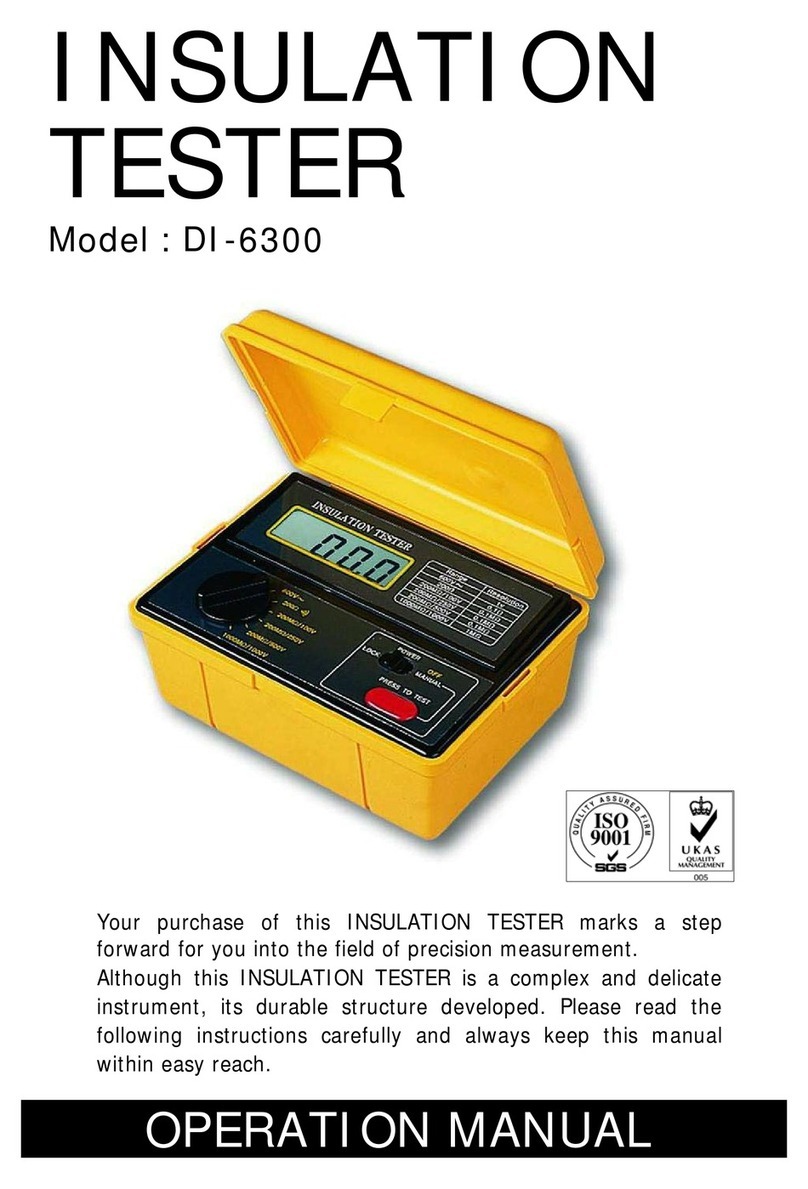
Lutron Electronics
Lutron Electronics DI-6300 Operation manual
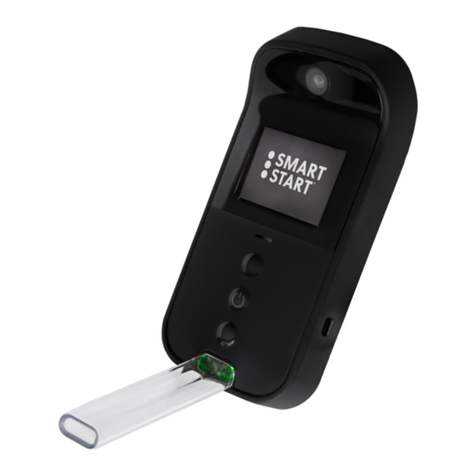
Smart Start
Smart Start SmartMobile Insight user manual
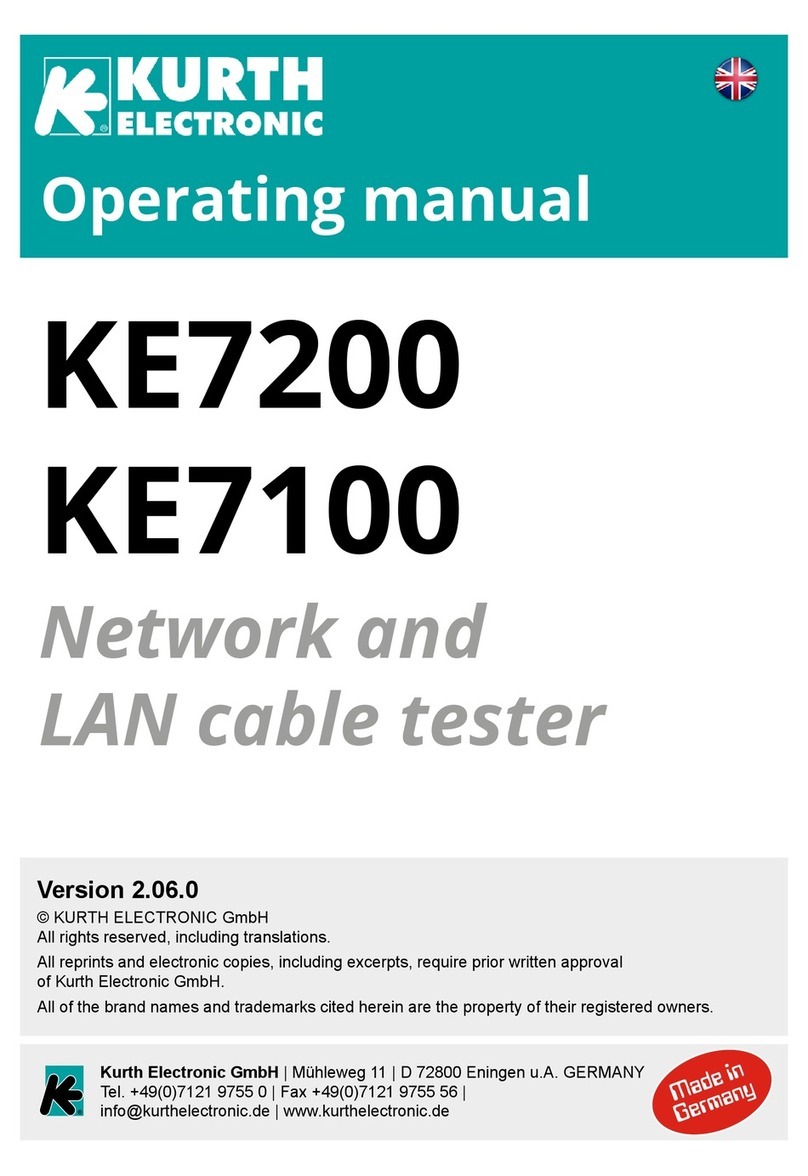
Kurth Electronic
Kurth Electronic KE7200 operating manual
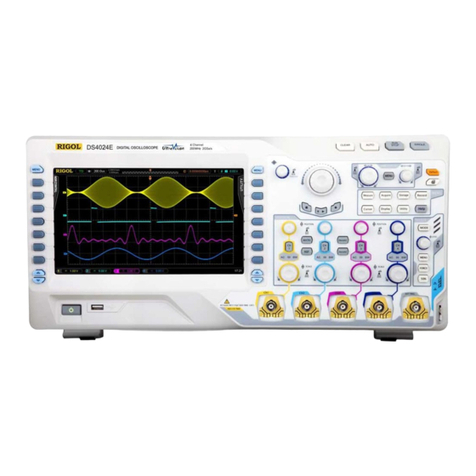
Rigol
Rigol DS4000E Series Programming guide
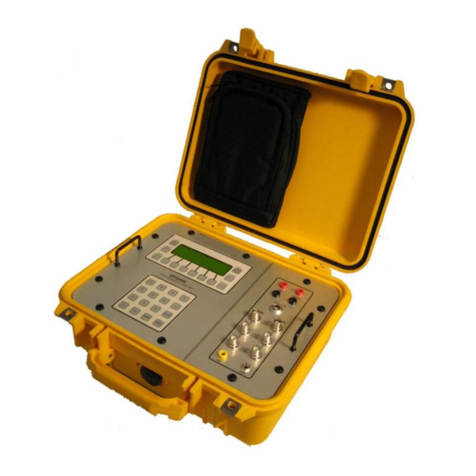
barfield
barfield DFQ40K User instruction manual
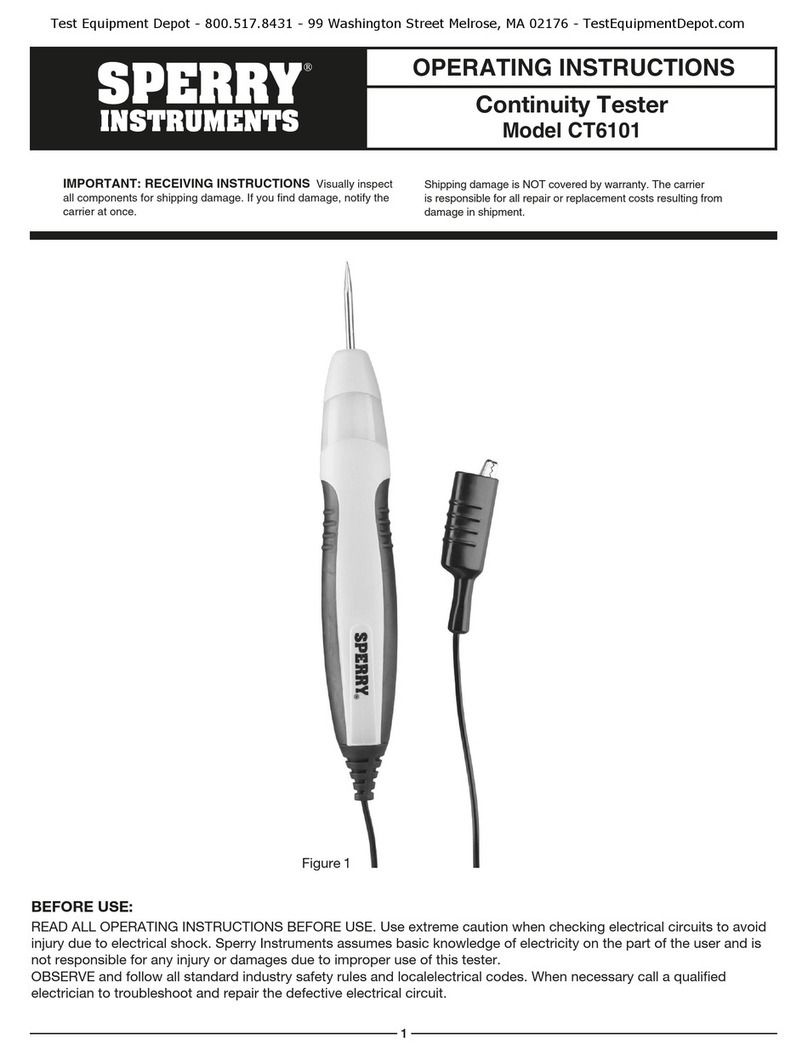
Sperry instrument
Sperry instrument CT6101 operating instructions

